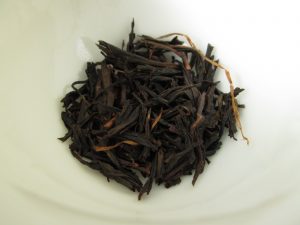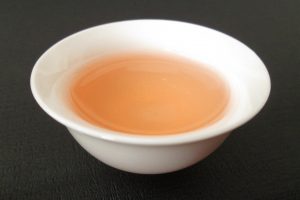 First of all I want to thank Geoffrey of the Steep Stories blog.
First of all I want to thank Geoffrey of the Steep Stories blog.
He sent me some rare Japanese teas as a gift, and this is one of them.
Japan specializes in green tea, but there are few producers that choose to make different types of tea, such as Takeo Tea Farm from Mie prefecture.
They developed their own method for making this organic oolong, but unfortunately they don’t specify how it works.
Reviewing my first Japanese Oolong
Oolongs are semi-oxidized teas, meaning that they are somewhere between a green tea (non oxidized) and a black tea (fully oxidized).
By its appearance, I would say that this oolong has a good deal of oxidation. It can easily be confused with a black tea.
I opened the package and found dark leaves rolled into a needle shape. Their aroma is sweet.
At yunomi.life the brewing guidelines are 3 grams of leaves, 200 ml (6.8 oz) of water at 80 °C (176 °F), and a steeping time of 2 minutes.
However, I’m not into Western style brewing, I’d rather use smaller cups and a higher leaf to water ratio. Thus, I decided to brew it in a gaiwan. Oolong is popular in China and Taiwan, so I think that brewing it their way would be best.
I used 3 grams of tea and 60 ml (2 oz) of water at 80 °C (176 °F) and made multiple short infusions, about 30 seconds each. The reason for the low volume of water is that my gaiwan is quite small and so are the cups. They are about the same size as those for drinking gyokuro.
I bought this gaiwan set from Amazon. Maybe it’s not as professional (it doesn’t have a saucer), but it is inexpensive and portable. The set consists of the gaiwan, a fairness pitcher, tweezers, and six cups. Plus, it comes with its own case 🙂
 For the first brew, I obtained a liquor with copper color and a light sweetness, almost like honey. The taste itself is mild, with hints of citrus and no bitterness.
For the first brew, I obtained a liquor with copper color and a light sweetness, almost like honey. The taste itself is mild, with hints of citrus and no bitterness.
The second brew produced a darker color, with a little more astringency but still delicious. The same thing happened for subsequent infusions, and I did six in total.
While I’m not a regular oolong drinker, I think that this tea is quite good.
If I’m not mistaken, this tea is milder than most oolongs. It’s probably better to use more leaves as opposed to less.
Have you tried a Japanese oolong yet? You can buy it here.





October 21, 2014
Interesting! But why did you brew it at 80C? I think full character may come out at much higher temperatures specially since the tea was much really oxidised well and tended towards red tea.
October 21, 2014
Hi Lochan
I just did it based on the producer’s guideline.
My idea was to use less water, so that I also needed less infusion time, but kept the temperature constant.
I should try with higher temperature, but the problem is that it was a small sample so I don’t have any more of it right now.
December 10, 2014
Oh also, Ricardo, meant to mention… you pour out the first brew don’t drink it. They call it the “wash.” You do it as fast as you can, literally rinsing the leaves with hot water. Unless I just misread and you did first wash the tea before brewing, in which case forgive me for telling you something you already know.
October 22, 2014
Very nice!
I’ve tried a Japanese Oolong from Yuuki-cha previously (their Miyazaki Kuchinashi), but much closer to a green than a black.
No bitterness or astringency, lightly floral and very limited Sencha-like undertones, but still very distinguishable from regular Oolongs.
Higher temperatures are fine too – pan fired teas seem to be more forgiving of hotter water and actually improve in aroma.
I’ll have to try some of the more oxidised ones, but can definitely recommend the greener ones for a refreshing change to the norm 🙂
All the best,
James
October 22, 2014
Hi James.
That’s an interesting tea, hopefully I’ll have a chance to try it as well.
October 24, 2014
Hola Ricardo,
Good comment as always, I know this tea and we can drink it without sugar. This kind of taste, something sweet, is very popular now, I think. My business partner in Taiwan, has also this kind of teas.
By the way we may also develop fermented Japanese green tea for next year.
October 24, 2014
Hola Hide-san
Thanks for the comment. Please tell me about your fermented Japapanese tea when it’s ready.
October 26, 2014
Hi Ricardo-
Really enjoyed reading this review. Also interesting that you noticed some citrus notes in the flavor, making this oolong rather unique. I’m also glad you provided the link to the Gaiwan…primarily because I’ve been looking for a easy-to-use carrying case (I have plenty of gaiwans, but not a traveling case, and the cost is reasonable). Thanks.
October 27, 2014
Hi Scott
Thanks for your comment. Hope that the gaiwan can cover your needs.
October 31, 2014
This was my favorite of the three Japanese oolongs I’ve tried. More going on. Glad you liked it, too.
October 31, 2014
I liked it a lot. Thanks again, Geoff!
December 10, 2014
Hey dude, just wanted to say its good to see some reviews for rarer japanese oolong teas. I am a huge fan of chinese oolong teas and am just starting to learn about the Japanese versions.
I would highly suggest brewing your tea at a higher temperature. It should brew out to be much darker than it looks in the photo. The standard formula for a small gaiwan like yours would be 3-5 grams of tea, and 208-212 degrees farenheit – BOILING. The best oolong teas, wuyi da hong pao for example, needs the hottest water. You won’t ruin the tea, it needs to be extracted hot. But you need to do it FAST. 10-30 seconds is all it takes.
In terms of water… don’t measure! You adjust the amount of tea, not the amount of water. You just fill to the top of your gaiwan.
Most recommendations are for too little tea and water remperatures too low, as well as TOO MUCH brewing time. Every time a chinese person makes me good Oolong tea, they do it like that – boiling water, small gaiwan, FAST brew. The amount of time is dictated by how fast you move, not how long you “wait.” The time it takes you to close the cap on the gaiwan, move your filter onto your fairness cup, place the fairness cup in pouring position, and pick up the gaiwan to pour, that’s enough time for the tea to brew. You only start “waiting” beyond 30 seconds for the later brews, say 8-20, depending on how many you get from your tea. Hope this feedback helps.
Unless the japanese have a completely different take on tea, you won’t be getting your flavor right at such low temperatures and with that little tea/water.
December 11, 2014
Hi Adam
Thanks for the oolong brewing tips, I’m not very familiar with this type of tea : )
I was using the producer’s guidelines but I’ll make sure to try brewing oolongs as you have suggested.
December 12, 2014
yeah I find that brewer’s guidelines tend to be a little off on most teas. also since I am no “expert” when it comes to japanese oolong (it doesn’t have the history of chinese oolong, nor do we have much information published about it in English) so I can only assume from the color and your description of the tea that it should be brewed and treated similarly. I have ordered a bunch of different japanese Oolong teas recently and can’t wait for them all to arrive for tasting…
December 12, 2014
Wow, if you ordered different ones from Japan you must really be into oolong.
I wish you a great time with your tasting!